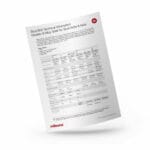This guide provides a clear, step-by-step process for mixing Semaglutide 5mg with bacteriostatic water. Precise mixing is crucial for accurate dosing and maintaining medication potency. While this guide offers comprehensive information, always consult your doctor or pharmacist for personalized advice.
Preparing Your Semaglutide Injection
Mixing Semaglutide correctly is essential for its effectiveness and safety. This section offers a detailed guide to ensure proper preparation.
Gathering Your Supplies
Before you begin, gather the following items:
- Semaglutide 5mg vial
- Vial of bacteriostatic water (not sterile water)
- Appropriate syringes and needles (consult your doctor for the correct sizes)
- Alcohol swabs
- Sharps container
Having everything readily available in a clean workspace makes the process easier and safer.
Mixing the Semaglutide
Temperature and Cleanliness: Allow the Semaglutide vial to reach room temperature for 10-15 minutes. Clean the rubber stopper of both the Semaglutide and bacteriostatic water vials with alcohol swabs.
Adding the Bacteriostatic Water: The amount of bacteriostatic water needed for a 5mg vial can vary. Sources suggest anywhere from 1.5ml to 5ml. This variation likely stems from different desired concentrations for different dosing regimens. For example, 1.5ml may be recommended for a concentration of approximately 0.33mg/ml, while higher volumes will result in lower concentrations. Always consult your doctor or the medication packaging for the precise volume required for your prescribed dosage. Slowly inject the prescribed amount of bacteriostatic water into the Semaglutide vial, aiming the stream against the vial’s sidewall to minimize agitation.
Mixing the Solution: Gently swirl or roll the vial between your palms until the Semaglutide powder is completely dissolved. Avoid shaking, as this can cause air bubbles and affect the medication. The resulting solution should be clear. If it’s cloudy, contains particles, or appears discolored, discard it and contact your healthcare provider.
Administering the Semaglutide Injection
This section outlines the steps for safe and effective administration of your Semaglutide injection.
Preparing the Syringe
Drawing the Dose: Using a new, sterile syringe, carefully draw the exact dose prescribed by your doctor. Double-check the measurement on the syringe to ensure accuracy.
Removing Air Bubbles: Gently tap the syringe to dislodge any air bubbles and push them out before injecting. This ensures you receive the full prescribed dose.
Injecting the Semaglutide
Injection Site Preparation: Choose your injection site. Common sites include the abdomen, thigh, or upper arm. Your doctor will likely recommend rotating injection sites to prevent skin irritation or lipohypertrophy. Clean the chosen area thoroughly with an alcohol swab.
Injection Technique: Pinch a fold of skin at the injection site and insert the needle at the angle recommended by your healthcare professional (usually 45 or 90 degrees). Slowly inject the Semaglutide, then gently withdraw the needle.
Post-Injection Care: Apply gentle pressure to the injection site with a clean cotton ball or gauze pad if needed. Monitor the site for any unusual reactions like excessive redness, swelling, or itching.
Safe Disposal
Immediately dispose of the used syringe and needle in a sharps container. Never reuse needles.
Important Considerations and Potential Issues
This section addresses additional information regarding Semaglutide use.
Why Bacteriostatic Water?
Bacteriostatic water contains benzyl alcohol, a preservative that inhibits bacterial growth and maintains the sterility and potency of the Semaglutide. Using regular sterile water or other diluents risks contamination and could render the medication ineffective or even harmful.
Dosage and Concentration
Different Semaglutide dosages require specific dilutions with bacteriostatic water. It is crucial to follow your doctor’s instructions precisely. For instance, while 1.5ml of bacteriostatic water is commonly used with a 5mg vial, this may not be appropriate for all dosages or desired concentrations. Understanding the concentration of your reconstituted Semaglutide is essential for accurate dosing.
Storage
Store reconstituted Semaglutide in the refrigerator according to the manufacturer’s instructions. The shelf life of the mixed solution varies depending on the specific product.
Hydration
While unrelated to the mixing process, adequate hydration is important for overall health and can help manage some common side effects of Semaglutide, such as nausea and constipation. Aim for at least 64 ounces (eight 8-ounce glasses) of water per day, but consult your doctor for personalized recommendations. Certain foods can also interact with medications like Trulicity, a similar GLP-1 receptor agonist. Learn more about which foods to avoid with Trulicity for optimal medication management.
Troubleshooting
- Undissolved Powder: If the Semaglutide powder doesn’t fully dissolve, do not use the mixture. Contact your pharmacist or doctor.
- Cloudy Solution: A cloudy solution after mixing suggests a problem. Discard the mixture and contact your healthcare provider.
This comprehensive guide provides detailed instructions for mixing and administering Semaglutide. However, remember that this information is for educational purposes and does not replace professional medical advice. Always consult with your doctor or pharmacist for personalized guidance and to address any specific concerns or questions. They are your best resource for safe and effective Semaglutide management.
- Fahaka Pufferfish Care Guide: Tank Setup, Diet, & Behavior - December 15, 2024
- Fahaka Puffer Care Guide: Expert Tips for Keeping Nile Puffers - December 15, 2024
- Decoding the F1BB Goldendoodle: Temperament, Coat, Health, and More - December 15, 2024














